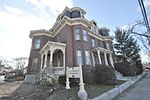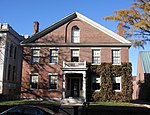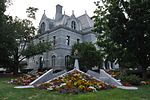2½ Beacon Street
Buildings and structures in Concord, New HampshireCommercial buildings completed in 1860Commercial buildings on the National Register of Historic Places in New HampshireNational Register of Historic Places in Concord, New Hampshire

2+1⁄2 Beacon Street, also known as the former New Hampshire State Prison Warehouse, is a historic commercial building at 2+1⁄2 Beacon Street in Concord, New Hampshire. Built in 1860 and enlarged in 1868, it is the only major surviving element of New Hampshire's first state prison complex, which was mostly torn down in the 1890s. The building was listed on the National Register of Historic Places in 1984.
Excerpt from the Wikipedia article 2½ Beacon Street (License: CC BY-SA 3.0, Authors, Images).2½ Beacon Street
Crosby Street, Concord
Geographical coordinates (GPS) Address Nearby Places Show on map
Geographical coordinates (GPS)
| Latitude | Longitude |
|---|---|
| N 43.211666666667 ° | E -71.5425 ° |
Address
Crosby Street 58
03301 Concord
New Hampshire, United States
Open on Google Maps











